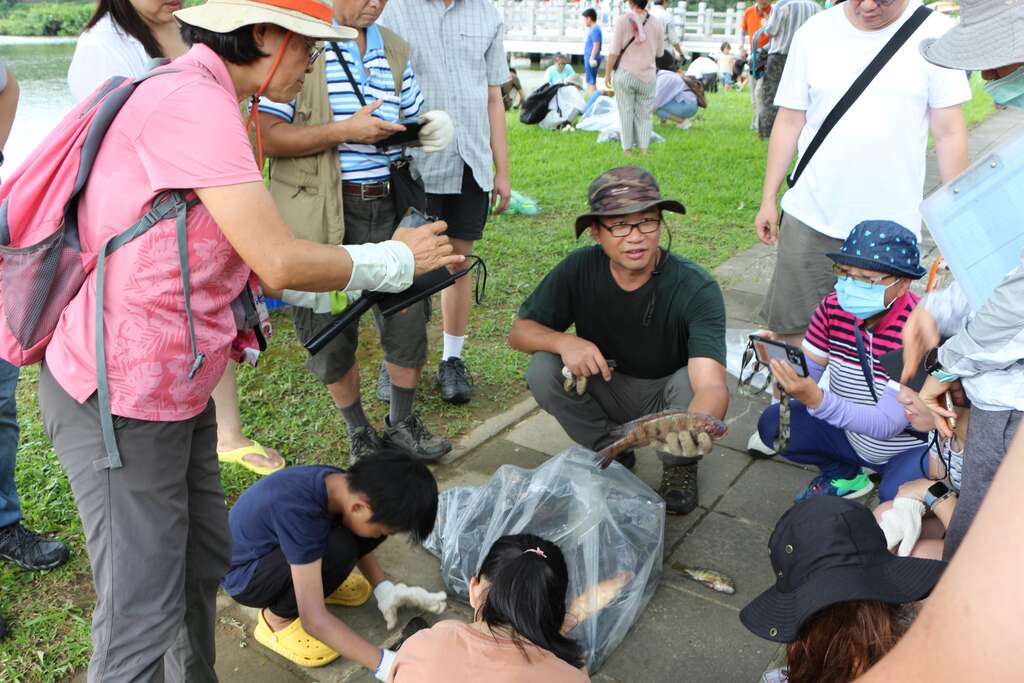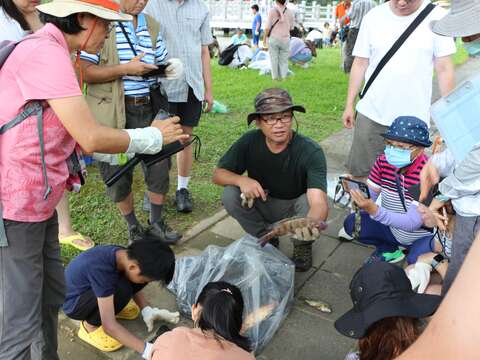Post date:2023-07-17
Updates:2023-07-17
407
To help remove invasive species from local habitats and restore native fish population, a series of related workshops took place at Dahu Park and Bihu Park, attracting both adults and children. This is the second year for the workshops to be held, and outstanding results have been achieved with the help of enthusiastic volunteers.

During the sessions, volunteers worked together to carry out the process of removing fish from nets, measuring, and record keeping. The instructors also took the opportunity to educate participants on the difference between introduced species and invasive species, as well as reminding them not to release introduced species into the habitat. The workshop at Dahu Park also saw the participation of seven children. During the afternoon, participants have a chance to remove introduced species by fishing. One of the kids caught a Taiwan bitterling, and the instructor helped release the native species back into the lake.
According to the Parks and Street Lights Office (PSLO), the Bihu workshop adopted tools such as gillnet and drag net to catch different types of fish. Gillnet are useful for trapping larger species, while drag nets have an easier time luring smaller fish.
The result of the workshops are as follows: Bihu workshop reported the removal of 57 introduced fish, including 26 Nile tilapia, 20 redbelly tilapia, 5 firemouth cichlid, 2 Indian glassy fish, 3 shubunkins, and 1 blood-red parrot cichlid. Likewise, a total of 323 introduced species were caught at the Dahu workshop, including 246 suckermouth catfish, 38 Nile tilapia, 25 redbelly tilapia, 4 redhead cichlid, and 10 shubunkins.
The sampling survey carried out during the workshop indicated that the top three advantages fish types at Dahu are respectively firemouth cichlid, suckermouth catfish, and Nile tilapia. Introduced species accounted for 85% of caught samples. Similarly, the catch at Bihu also yielded 91.7% introduced species, with the top three advantageous fish being Nile tilapia, firemouth cichlid, and Indian glassy fish.
The high percentage of introduced species is an indicator that removal of invasive wildlife should be carried out as soon as possible to protect the eco environment.

During the sessions, volunteers worked together to carry out the process of removing fish from nets, measuring, and record keeping. The instructors also took the opportunity to educate participants on the difference between introduced species and invasive species, as well as reminding them not to release introduced species into the habitat. The workshop at Dahu Park also saw the participation of seven children. During the afternoon, participants have a chance to remove introduced species by fishing. One of the kids caught a Taiwan bitterling, and the instructor helped release the native species back into the lake.
According to the Parks and Street Lights Office (PSLO), the Bihu workshop adopted tools such as gillnet and drag net to catch different types of fish. Gillnet are useful for trapping larger species, while drag nets have an easier time luring smaller fish.
The result of the workshops are as follows: Bihu workshop reported the removal of 57 introduced fish, including 26 Nile tilapia, 20 redbelly tilapia, 5 firemouth cichlid, 2 Indian glassy fish, 3 shubunkins, and 1 blood-red parrot cichlid. Likewise, a total of 323 introduced species were caught at the Dahu workshop, including 246 suckermouth catfish, 38 Nile tilapia, 25 redbelly tilapia, 4 redhead cichlid, and 10 shubunkins.
The sampling survey carried out during the workshop indicated that the top three advantages fish types at Dahu are respectively firemouth cichlid, suckermouth catfish, and Nile tilapia. Introduced species accounted for 85% of caught samples. Similarly, the catch at Bihu also yielded 91.7% introduced species, with the top three advantageous fish being Nile tilapia, firemouth cichlid, and Indian glassy fish.
The high percentage of introduced species is an indicator that removal of invasive wildlife should be carried out as soon as possible to protect the eco environment.
 Invasive Species Removal Workshop Takes Place at Parks in Neihu District
Invasive Species Removal Workshop Takes Place at Parks in Neihu District



